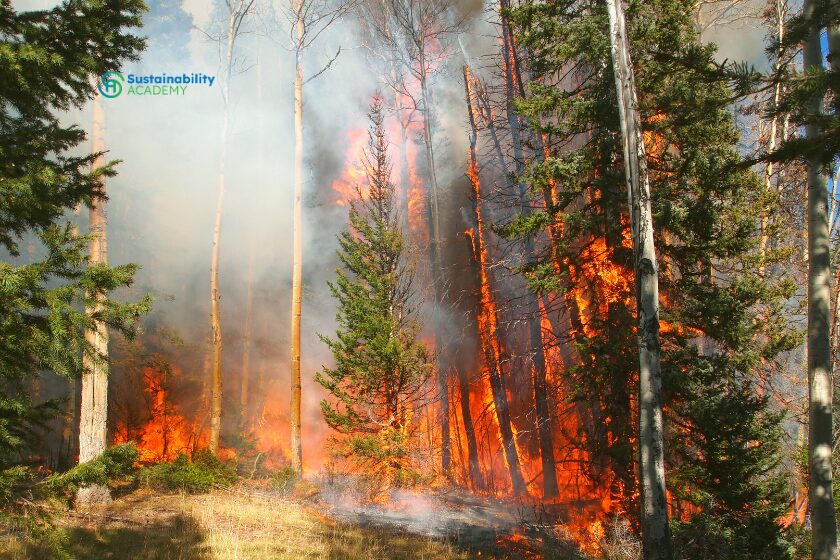The devastating California wildfires of 2025 serve as a stark reminder of how climate-related risks directly affect both the environment and the global economy. As extreme weather events grow in frequency and intensity, organizations are being forced to rethink their climate risk ESG management strategies. What was once seen as a remote environmental issue is now a central concern in boardrooms, investor reports, and sustainability frameworks worldwide. Understanding and managing these risks is no longer optional—it’s fundamental to building business resilience and achieving long-term sustainability.
Wildfires and Their ESG Implications
Wildfires like those that struck Los Angeles in early 2025 have significant environmental, social, and governance consequences. The fires released massive amounts of carbon dioxide and methane into the atmosphere, worsening global warming and air quality. According to the Environmental Protection Agency (EPA), wildfires now account for nearly 20% of total U.S. greenhouse gas emissions during severe seasons. The fine particulate matter (PM2.5) generated has increased respiratory illnesses, disproportionately impacting vulnerable communities and raising social equity concerns. On the governance side, many companies with supply chains or facilities in affected areas face disruptions, higher insurance costs, and investor scrutiny over inadequate climate risk disclosure. These realities demonstrate how climate risk in ESG frameworks must extend beyond carbon accounting to include physical, financial, and human impacts.
Why Climate Risk Belongs in ESG Strategy
The integration of climate risk into ESG strategy allows companies to anticipate and mitigate disruptions while maintaining stakeholder trust. Investors and regulators increasingly demand transparent climate risk reporting aligned with frameworks such as the Task Force on Climate-related Financial Disclosures (TCFD), the ISSB, and the Corporate Sustainability Reporting Directive (CSRD). These standards require organizations to evaluate both transition risks (like carbon pricing or regulatory changes) and physical risks (such as floods, droughts, and wildfires). Companies that embed climate risk into governance and decision-making are better equipped to adapt to climate uncertainty, safeguard assets, and maintain long-term profitability. The 2024 McKinsey Global Resilience Report found that firms with active climate risk management outperform peers in crisis response and post-event recovery.
From Wildfire Impact to Resilient Systems
Wildfires illustrate how environmental and economic systems are interconnected. Beyond the loss of forests, biodiversity, and infrastructure, wildfires disrupt water supplies, cause soil degradation, and contribute to food insecurity. These cascading effects highlight the importance of climate resilience in ESG frameworks. For example, utility companies in California now incorporate wildfire risk modeling into their operational and investment planning. By assessing risk exposure through satellite data and AI-driven analytics, they can prioritize vegetation management, enhance grid resilience, and protect communities. This data-based approach is a leading example of ESG climate strategy in action—where sustainability and innovation combine to prevent future losses.
Building Climate Resilience Through Education and Strategy
Organizations seeking to strengthen their ESG climate strategy must invest in both technology and people. While digital tools like predictive analytics and carbon management platforms are vital, human expertise remains the cornerstone of effective implementation. The Certified Climate Resilient Officer (CRO) course by the Sustainability Academy equips professionals to identify, assess, and mitigate climate risks using globally recognized methodologies. Participants learn how to design resilience strategies, communicate risks transparently, and align with international ESG disclosure frameworks. Similarly, the Online Certificate on Carbon Reduction and Net Zero Strategies provides practical guidance for organizations aiming to cut emissions and achieve long-term carbon neutrality.
Case Study: PG&E’s Climate Risk Transformation
One of the most striking examples of ESG risk management comes from California’s largest utility, Pacific Gas & Electric (PG&E). After years of wildfire-related liabilities, PG&E has completely overhauled its climate strategy. The company invested over $5 billion in grid modernization and wildfire mitigation technologies, including underground power lines, real-time monitoring sensors, and AI-based fire detection systems. Moreover, PG&E introduced an internal climate risk committee that reports directly to the board—ensuring governance accountability for environmental and safety performance. This transformation demonstrates how companies can rebuild trust and operational resilience through proactive climate risk ESG management.
Turning Lessons into Action
The environmental and financial toll of wildfires reinforces one core lesson: climate risk is business risk. To prepare for the next decade of environmental volatility, companies must embed climate resilience reporting into ESG disclosures and train teams to manage extreme weather events. Actions include:
-
Conducting scenario analyses to assess climate impacts across operations.
-
Setting science-based targets for emissions and adaptation.
-
Investing in nature-based solutions such as reforestation and ecosystem restoration.
-
Ensuring board-level oversight of climate and sustainability metrics.
By treating ESG as a strategic framework rather than a compliance exercise, organizations can transform crisis management into long-term value creation.
The Road Ahead: Integrating Climate Risk into Corporate Culture
As the 2025 wildfire season reminds us, sustainability cannot be reactive. Businesses, governments, and individuals must build proactive systems that anticipate risk and accelerate recovery. Embedding climate risk management in ESG ensures that sustainability becomes part of corporate DNA, guiding decision-making from the boardroom to the supply chain. Education is the foundation of that transformation. Through professional certifications and continuous learning, sustainability leaders can empower their organizations to act decisively in the face of a changing climate.

